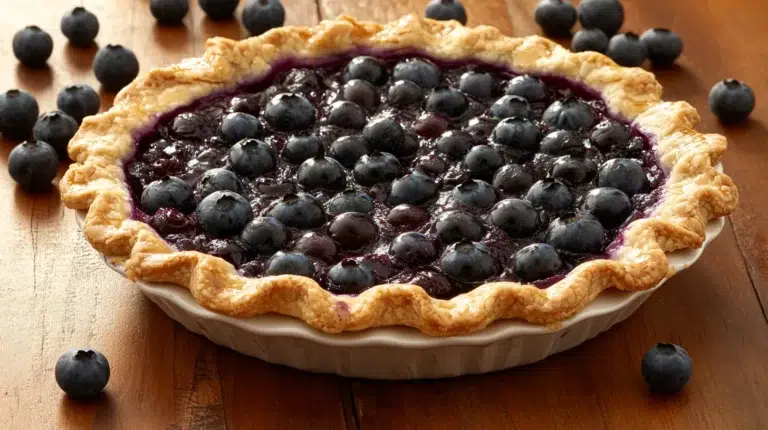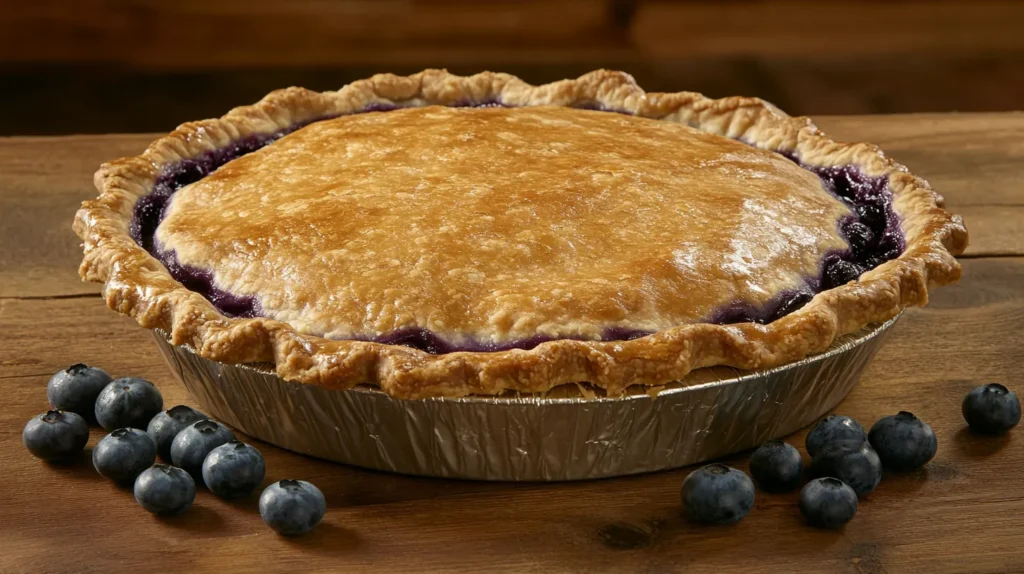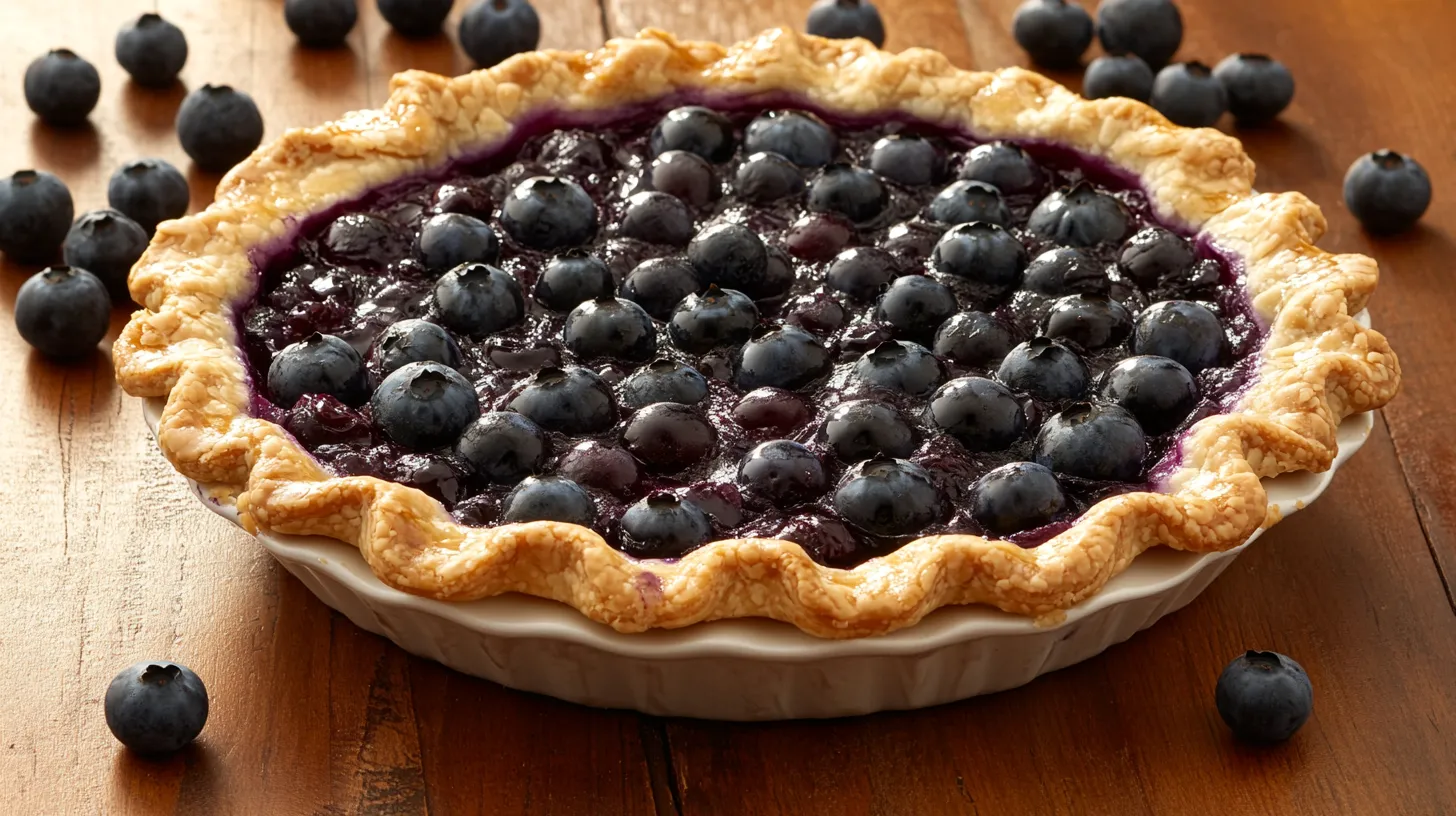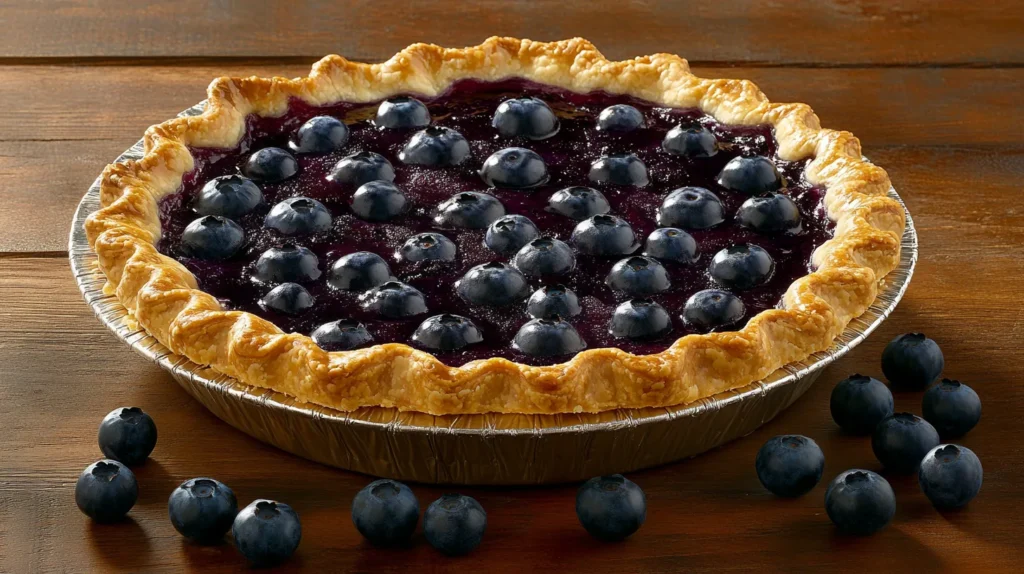
Blueberry pie is a classic dessert loved for its sweet, tangy, and juicy filling. But what are the ingredients in blueberry pie filling that make it so irresistible? Whether you’re making it from scratch or using a pre-made version, the right ingredients play a crucial role in creating the perfect consistency and flavor.
In this guide, we’ll break down every essential ingredient, explore different variations, and provide expert tips to ensure your blueberry pie filling is always flawless. Plus, we’ll answer some frequently asked questions and discuss the best ways to store your homemade filling.
Table of Contents
Table of Contents

What Is Blueberry Pie Filling?
Blueberry pie filling is a thick, fruity mixture made primarily from blueberries, sugar, and a thickening agent. Unlike fresh blueberries, which release juices when baked, pie filling is designed to be pre-cooked or thickened to maintain a luscious texture inside the crust.
Store-bought pie fillings are often loaded with preservatives and artificial ingredients, but making your own allows you to control sweetness, texture, and flavor. If you’re looking for healthier options, there are also sugar-free and gluten-free alternatives that still deliver delicious results.
Understanding how the ingredients work together can help you create the perfect homemade blueberry pie filling. According to the National Center for Home Food Preservation, using natural thickeners and proper cooking techniques ensures a longer shelf life and better consistency.
Essential Ingredients in Blueberry Pie Filling
1. Blueberries – The Star Ingredient
The foundation of any blueberry pie filling is, of course, the blueberries. Choosing the right ones will determine the flavor and texture of your pie.
- Fresh blueberries: Best for seasonal pies, offering natural sweetness and firmness.
- Frozen blueberries: Great for year-round baking, but require adjustments in thickening agents to account for excess moisture.
For the best results, opt for wild blueberries, which have a more concentrated flavor and deeper color.
2. Sweeteners – Balancing the Flavor
Blueberries can be naturally tart, so sweeteners help create a perfectly balanced filling.
- Granulated sugar – The most common choice, helping to macerate the berries and create syrup.
- Brown sugar – Adds a richer, caramel-like depth to the filling.
- Honey or maple syrup – Great for natural sweetness, but they can slightly alter the texture.
- Sugar substitutes (monk fruit, stevia, erythritol) – Ideal for low-sugar or keto-friendly pies.
The Harvard T.H. Chan School of Public Health suggests using natural sweeteners for a healthier alternative while still maintaining great taste.
3. Thickening Agents – Preventing a Runny Filling
No one wants a soggy, watery blueberry pie. The right thickening agent ensures your filling holds its shape.
- Cornstarch – The most common thickener, creating a smooth and glossy texture.
- Flour – A simple thickener but can create a cloudier filling.
- Tapioca starch – Produces a clear, jelly-like consistency and works well for fruit pies.
- Pectin – Often used for jams, adding thickness without excess starchiness.
Each thickener works differently, so choose based on personal preference and dietary needs. If you’re avoiding cornstarch, you might prefer tapioca starch or pectin instead.
4. Acidic Ingredients – Enhancing the Flavor
A little acidity brings out the natural sweetness in blueberries and prevents the filling from tasting flat.
- Lemon juice – The most popular choice, balancing the sweetness and brightening the flavor.
- Apple cider vinegar – Adds a subtle tang and enhances fruit flavor.
- Citric acid – A powerful acidifier used in store-bought fillings.
Adding just a teaspoon of lemon juice can transform the entire depth of flavor in your pie.
5. Flavor Enhancers – Spices & Aromatics
While blueberries have an amazing flavor on their own, adding spices and extracts elevates the taste.
- Cinnamon & nutmeg – Warm, aromatic spices that add depth.
- Vanilla extract – Enhances the overall sweetness.
- Almond extract – Complements blueberries with a subtle nutty note.
Experiment with different spices to find your signature blueberry pie filling flavor.
6. A Pinch of Salt – The Secret Ingredient
Salt enhances all the flavors in your filling. A small pinch balances sweetness and brings out the richness of the blueberries.
7. Butter – For a Silky Finish
Adding a small pat of butter just before baking gives the filling a velvety, luxurious texture. It’s optional, but highly recommended for extra richness.
VaVariations of Blueberry Pie Filling
Blueberry pie filling is incredibly versatile, and you can easily customize it to suit different dietary needs, preferences, or ingredient availability. Whether you’re looking for a traditional recipe, a healthier alternative, or a special dietary modification, there’s a version of blueberry pie filling that’s perfect for you.
Here are some of the best variations to try:
1. Classic Blueberry Pie Filling – The Timeless Favorite
This is the traditional, tried-and-true blueberry pie filling recipe that has been loved for generations. It includes:
✅ Fresh or frozen blueberries – The star ingredient.
✅ Granulated sugar – For sweetness and balance.
✅ Cornstarch – The go-to thickener for a smooth, glossy consistency.
✅ Lemon juice – Enhances the fruit’s natural flavor and prevents the filling from tasting too sweet.
✅ Butter (optional) – A small pat of butter gives the filling a rich, velvety finish.
This version delivers the perfect balance of sweetness, thickness, and tartness, making it the most popular choice for homemade blueberry pies.
2. Low-Sugar Blueberry Pie Filling – A Diabetic-Friendly Option
If you want to reduce sugar content without compromising on flavor, you can make a low-sugar or sugar-free blueberry pie filling.
✅ Replace granulated sugar with:
- Monk fruit sweetener (zero-calorie natural alternative).
- Stevia or erythritol (keto-friendly options).
- Honey or maple syrup (for a natural sweetener with lower glycemic impact).
✅ Adjust the thickener:
- Cornstarch works fine, but xanthan gum or psyllium husk can also be used for a lower-carb option.
This version is perfect for those on a diabetic, keto, or low-carb diet, allowing you to enjoy blueberry pie without blood sugar spikes.
3. Gluten-Free Blueberry Pie Filling – Safe for Celiac & Gluten Sensitivities
Traditional blueberry pie filling often uses flour as a thickener, making it unsuitable for those with gluten intolerance. However, you can easily make it gluten-free by swapping out the thickener.
✅ Replace flour with:
- Tapioca starch – Gives a smooth, jelly-like texture.
- Arrowroot powder – Works like cornstarch but is grain-free.
- Cornstarch (certified gluten-free) – A simple one-to-one swap.
The result is a rich, thick, and glossy filling that’s completely gluten-free without sacrificing texture or flavor.
4. Vegan Blueberry Pie Filling – Dairy-Free & Plant-Based
If you follow a vegan diet, you’ll need to avoid dairy-based ingredients, such as butter, which is often used to enhance the richness of pie fillings. Thankfully, it’s easy to make a plant-based blueberry pie filling without compromising taste.
✅ Use a plant-based thickener:
- Arrowroot powder – A grain-free, neutral-flavored thickener.
- Agar-agar – A seaweed-based gelatin substitute for a firmer filling.
- Pectin – The same ingredient used in making jams and jellies.
✅ Skip the butter:
- A small amount of coconut oil or vegan butter can be added for richness.
This version is perfectly smooth, naturally sweet, and entirely plant-based, making it an excellent choice for vegan baking.
5. Canned vs. Fresh Homemade Blueberry Pie Filling – Which One is Better?
Some people prefer the convenience of canned blueberry pie filling, while others swear by homemade versions. Here’s a quick comparison to help you choose:
Canned Blueberry Pie Filling:
✅ Convenient – Ready to use straight from the can.
✅ Shelf-stable – Can be stored for months or even years.
❌ High in preservatives & artificial flavors – May contain corn syrup, food coloring, or additives.
❌ Less control over sweetness & thickness – Often too sweet or too thin.
Homemade Blueberry Pie Filling:
✅ 100% fresh ingredients – No preservatives or artificial additives.
✅ Customizable – Adjust the sweetness, thickness, and spices to your preference.
✅ Healthier alternative – You control the ingredients.
❌ Shorter shelf life – Needs to be stored properly in the fridge or freezer.
If you love homemade fruit-based toppings, check out this homemade blueberry compote recipe—it can also be used as a filling for pies, crepes, and desserts!
Which Blueberry Pie Filling Variation Is Right for You?
Choosing the best blueberry pie filling depends on your dietary preferences and needs. Here’s a quick summary to help you decide:
| Variation | Best For | Key Ingredient Swap |
|---|---|---|
| Classic | Traditional, full-flavor pie | Sugar, cornstarch, lemon juice |
| Low-Sugar | Diabetic, keto, low-carb diets | Monk fruit, stevia, or erythritol |
| Gluten-Free | Celiac disease, gluten sensitivity | Tapioca starch or arrowroot |
| Vegan | Dairy-free, plant-based diets | Agar-agar, coconut oil |
| Canned vs. Homemade | Convenience vs. Freshness | Preservatives vs. natural ingredients |
Whichever variation you choose, the key to a great blueberry pie is balancing the sweetness, acidity, and thickness for a perfectly set filling that enhances the flaky crust.
Would you like even more blueberry dessert ideas? Check out what makes a compote? for additional inspiration! 😊
FAQs : Blueberry Pie Filling Storage & Troubleshooting
Can I Use Frozen Blueberries Instead of Fresh?
Yes! Frozen blueberries work just as well as fresh ones, but they release more liquid during baking. This extra moisture can make the filling too runny if you don’t adjust your recipe accordingly.
How to Use Frozen Blueberries Without Ruining Your Pie:
✅ Don’t Thaw Before Baking – Thawing releases excess juice, making the filling watery. Use the berries straight from the freezer.
✅ Increase the Thickening Agent – Add 1-2 extra teaspoons of cornstarch, tapioca starch, or flour to absorb the additional moisture.
✅ Simmer the Filling Before Baking – If making homemade pie filling, cook the frozen berries with sugar and thickener until the juices reduce and thicken.
✅ Bake Longer – Pies with frozen berries may need an extra 5-10 minutes to fully set.
✅ Check for Bubbling – Ensure the filling is bubbling at the center before removing it from the oven.
Using frozen berries is a great option for off-season baking or when fresh blueberries aren’t available. Just adjust your thickener and baking time for the best results!
What Can I Use Instead of Cornstarch?
Cornstarch is one of the most common thickeners for fruit pie fillings, but if you need an alternative due to dietary restrictions or preference, try these options:
✅ Tapioca Starch – A great gluten-free thickener that creates a clear, glossy filling. Works well for juicy fruits like blueberries.
✅ Flour – A simple and effective option, but it creates a slightly cloudier filling compared to cornstarch.
✅ Pectin – Naturally found in fruit, pectin creates a firmer, jam-like filling when combined with sugar and acid (like lemon juice).
✅ Arrowroot Powder – A good substitute for cornstarch that creates a smooth, shiny consistency but may lose thickening power if overcooked.
💡 Pro Tip: If substituting cornstarch, use the following conversion:
- 1 tablespoon cornstarch = 2 tablespoons flour
- 1 tablespoon cornstarch = 1.5 teaspoons tapioca starch
- 1 tablespoon cornstarch = 2 teaspoons arrowroot powder
Choosing the right thickener depends on texture preference and dietary needs.

Homemade Blueberry Pie Filling
Ingredients
Equipment
Method
- **Prepare Blueberries:** Rinse fresh blueberries and drain well. If using frozen, do not thaw — use straight from the freezer.
- **Combine Ingredients:** In a medium saucepan, mix sugar, cornstarch, salt, and lemon zest. Add blueberries and lemon juice.
- **Cook the Filling:** Place over medium heat, stirring frequently until the mixture begins to bubble and thicken (about 10–12 minutes).
- **Add Flavor:** Once thickened, stir in vanilla extract and butter (if using). Continue cooking for 1 minute until glossy.
- **Cool:** Remove from heat and let cool completely before filling your pie crust.
- **Store:** Keep refrigerated in an airtight jar for up to 5 days or freeze for up to 6 months.
Notes
Calories: 140 kcal
Carbohydrates: 35 g
Protein: 1 g
Fat: 1 g
Fiber: 3 g
Sugar: 29 g
Sodium: 60 mg
Why Is My Blueberry Pie Filling Runny?
A runny or watery blueberry pie filling is a common issue, but it can be fixed! Here are the most likely causes and solutions:
1. Not Enough Thickener Was Used
- If your filling is too thin, it may be because not enough cornstarch, flour, or tapioca starch was added.
- Solution: Increase the amount of thickener slightly (start with an extra ½ to 1 teaspoon).
2. The Pie Wasn’t Baked Long Enough
- Pie fillings need enough time to fully thicken. If removed too soon, the filling hasn’t had time to set properly.
- Solution: Bake until the filling is bubbling in the center, not just at the edges.
3. Frozen Blueberries Released Too Much Liquid
- Frozen berries contain more water than fresh ones, which can create excess juice.
- Solution: Either pre-cook the filling before adding it to the pie shell or increase the thickening agent when using frozen blueberries.
4. The Pie Wasn’t Cooled Long Enough
- Cutting into a pie too soon after baking prevents the filling from setting.
- Solution: Let the pie cool for at least 2-3 hours before slicing. The filling will firm up as it cools.
💡 Pro Tip: To test if your filling is thick enough before baking, scoop some onto a spoon—if it coats the spoon without dripping too quickly, it’s ready!
How Long Does Homemade Blueberry Pie Filling Last?
Proper storage is key to keeping your blueberry pie filling fresh and safe to eat.
Refrigerator Storage:
✅ Shelf Life: 4-5 days
✅ Storage Method: Keep it in an airtight container or glass jar in the fridge.
✅ Best Practice: Let the filling cool completely before refrigerating to prevent condensation and excess moisture.
Freezer Storage:
✅ Shelf Life: Up to 6 months
✅ Storage Method: Store in freezer-safe bags or airtight containers.
✅ How to Thaw: Defrost overnight in the refrigerator, then reheat gently on the stove before use.
💡 Pro Tip: Freeze blueberry pie filling in pre-portioned containers so you can thaw only what you need.
For more storage tips, visit homemade blueberry compote storage.
Expert Tips for the Best Blueberry Pie Filling
- Use a mix of fresh and frozen blueberries for deeper flavor.
- Pre-cook the filling slightly to ensure thick consistency.
- Let the pie cool completely before slicing to allow the filling to set.
Following these tips will guarantee a perfectly thick and flavorful blueberry pie filling every time!

Conclusion
Now that you know what are the ingredients in blueberry pie filling, you can confidently create the perfect homemade version. The balance of blueberries, sweeteners, thickeners, and acidity is key to achieving the ideal texture and taste.
Whether you prefer a classic recipe, a low-sugar alternative, or a gluten-free version, the right combination of ingredients makes all the difference. Try experimenting with different spices, sweeteners, and thickeners to find your favorite version!
Looking for more delicious fruit-based recipes? Check out what makes a compote? for additional inspiration! 😊
